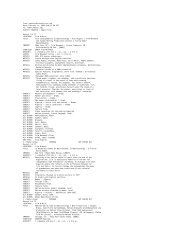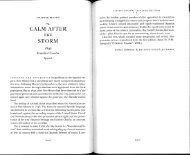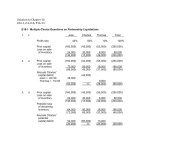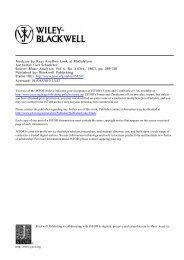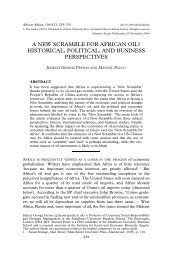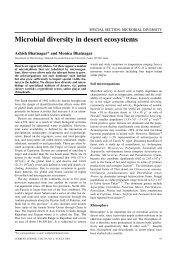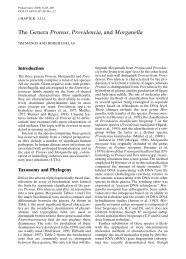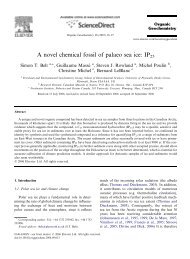The Genus Serratia
The Genus Serratia
The Genus Serratia
You also want an ePaper? Increase the reach of your titles
YUMPU automatically turns print PDFs into web optimized ePapers that Google loves.
CHAPTER 3.3.11 <strong>The</strong> <strong>Genus</strong> <strong>Serratia</strong> 223<br />
<strong>Serratia</strong> marcescens, S. proteamaculans and<br />
S. liquefaciens are considered potential insect<br />
pathogens (Bucher, 1960). <strong>The</strong>y cause a lethal<br />
septicemia after penetration into the hemocoel.<br />
More than 70 species of insects were found to be<br />
susceptible to inoculation with <strong>Serratia</strong> (Bucher,<br />
1963a). <strong>The</strong> lethal dose (LD 50) of inoculated <strong>Serratia</strong><br />
(by intrahemocoelic injection) was calculated<br />
for several insects 10–50 <strong>Serratia</strong> cells per<br />
grasshopper (Bucher, 1959), 5.1 cells per adult<br />
bollweevil (Slatten and Larson, 1967), 7.5 and<br />
14.5 cells per third and fourth instar larva<br />
(respectively) of Lymantria dispar (Podgwaite<br />
and Cosenza, 1976), and 40 cells per Galleria<br />
mellonella larva (Stephens, 1959). <strong>The</strong> LD 50 of<br />
ingested S. marcescens is much higher. <strong>The</strong><br />
hemolymph of insects—normally bactericidal for<br />
nonpathogens—cannot prevent multiplication of<br />
potential pathogens (Stephens, 1963). Lecithinase,<br />
proteinase, and chitinase play a role in the<br />
virulence of <strong>Serratia</strong> for insects, and purified<br />
<strong>Serratia</strong> proteinase or chitinase is very toxic<br />
when injected into the hemocoel (Kaska, 1976;<br />
Lysenko, 1976). <strong>Serratia</strong> strains in the insect<br />
digestive tract probably originate from plants.<br />
<strong>The</strong> multiplication of <strong>Serratia</strong> strains in the insect<br />
digestive tract has not been quantitatively studied.<br />
Antibacterial substances in ingested leaves<br />
might interfere with bacterial multiplication, but<br />
<strong>Serratia</strong> strains were found resistant to these<br />
(Kushner and Harvey, 1962). How potential<br />
pathogens such as <strong>Serratia</strong> can enter the<br />
hemolymph from the gut is generally unknown.<br />
However, spontaneous gut rupture, which happens<br />
in about 10% of grasshoppers, may allow<br />
<strong>Serratia</strong> strains to invade the hemocoel (Bucher,<br />
1959). Direct injection occurs when Itoplectis<br />
conquisitor contaminated with <strong>Serratia</strong> stings<br />
host pupae to oviposit into their bodies (Bucher,<br />
1963b). <strong>Serratia</strong> epizootics are common among<br />
reared insects (Bucher, 1963a). However, until<br />
recently, no genuine epizootic of <strong>Serratia</strong> infection<br />
among insects had been observed in the field.<br />
Strains of S. entomophila and S. proteamaculans<br />
can be pathogenic for the grass grub Costelytra<br />
zealandica, which is a major pasture pest in<br />
New Zealand (Stucki and Jackson, 1984; Trought<br />
et al., 1982). Larvae of Costelytra zealandica feed<br />
on grass, clover, and other plant roots. Typically,<br />
their populations grow to a peak (about 600 larvae/m<br />
2 ) in 4 to 6 years after the pasture is sown<br />
and then collapse (to about 50 larvae/m 2 ). Grass<br />
grub population collapse was found associated<br />
with the presence of a disease called amber disease<br />
(Trought et al., 1982). S. entomophila and S.<br />
proteamaculans were isolated from naturally<br />
infected larvae and shown experimentally to produce<br />
the disease when transmitted orally to<br />
healthy larvae (Grimont et al., 1988; Stucki and<br />
Jackson, 1984). <strong>The</strong> bacteria are ingested from<br />
the soil. Infected larvae stop feeding within a few<br />
days, become translucent and then amber colored<br />
and lose weight until death occurs 4 to 6<br />
weeks later. <strong>The</strong> bacteria colonize the gut and<br />
cause disease symptoms without invading the<br />
hemocoele. Field trials have shown that control<br />
of the grass grub was feasible by application of<br />
S. entomophila suspensions on pastures (Jackson<br />
and Pearson 1986). Reductions of 30 to 59% in<br />
the larval populations were obtained, with 47%<br />
of the remaining larvae being infected. Such bacterial<br />
treatment resulted in a 30% increase in<br />
grass production (dry matter).<br />
<strong>Serratia</strong> in Vertebrates<br />
<strong>Serratia</strong> has been associated with chronic<br />
infections of cold-blooded vertebrates: nodular<br />
infection of Anolis equestris, the Cuban lizard<br />
(Duran-Reynals and Clausen, 1937); subcutaneous<br />
abscess of iguanid lizards (Boam et al., 1970);<br />
arthritis in the lizard Tupinambis tequixin (Ackerman<br />
et al., 1971); and ulcerative disease in the<br />
painted turtle Chrysemys picta (Jackson and Fulton,<br />
1976). <strong>Serratia</strong> strains have also been recovered<br />
from the healthy, small, green pet turtle<br />
Pseudemys scripta elegans (McCoy and Seidler,<br />
1973) and from geckos and turtles in Vietnam<br />
(Capponi et al., 1956).<br />
Poultry may be contaminated with <strong>Serratia</strong>. A<br />
deadly <strong>Serratia</strong> epizootic among chick embryos<br />
was observed in a Japanese hatchery (Izawa et<br />
al., 1971). <strong>The</strong> hens carried S. marcescens in their<br />
digestive tract, but were themselves unaffected.<br />
Contamination of chicken carcasses with S. liquefaciens<br />
(Lahellec et al., 1975) and spoilage of<br />
eggs by red-pigmented <strong>Serratia</strong> (Alford et al.,<br />
1950) have been reported. A disseminated suppurative<br />
infection in a blue and gold macaw (Ara<br />
ararauna) affected with a chronic lymphoid atrophy<br />
has also been recorded (Quesenberry and<br />
Short, 1983).<br />
<strong>Serratia</strong> strains (mostly red-pigmented) are<br />
responsible for 0.2–1.5% of cases of mastitis in<br />
cows (Barnum et al., 1958; Roussel et al., 1969;<br />
Wilson, 1963). Raw milk, therefore, may occasionally<br />
contain <strong>Serratia</strong> spp., and S. liquefaciens<br />
and S. grimesii are common in dairy products<br />
(Grimes and Hennerty, 1931). <strong>Serratia</strong> strains<br />
have been involved in septicemia in foals (Deom<br />
and Mortelmans, 1953), goats (Wijewanta and<br />
Fernando, 1970), and pigs (Brisou and Cadeillan,<br />
1959); they have also been implicated in conjunctivitis<br />
of the horse (Carter, 1973) and abortion in<br />
cows (Smith and Reynolds, 1970). <strong>The</strong> isolation<br />
of <strong>Serratia</strong> from the anal sac of the red fox Vulpes<br />
vulpes (Gosden and Ware, 1976) has been<br />
reported.<br />
<strong>Serratia</strong> strains have rarely been systematically<br />
searched for in the gut of animals. S. fonticola



